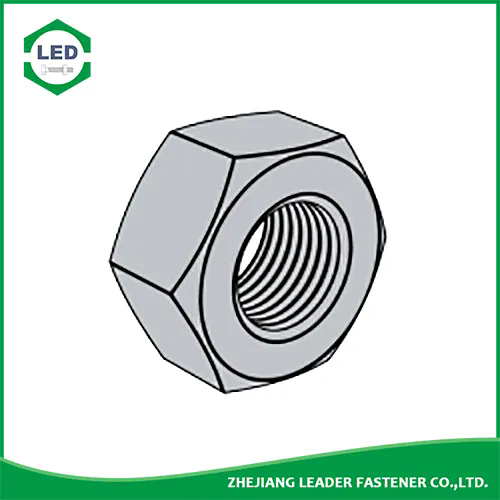Hex Nut: A Small Component with a Big Role in Engineering and Construction
2025-04-07
In the world of hardware and mechanical design, the hex nut is one of the most fundamental and widely used fasteners. While it might seem like a simple component, the hex nut plays a crucial role in ensuring the strength, stability, and functionality of various mechanical systems. Whether you're working on a car, assembling furniture, or constructing a building, hex nuts are everywhere, quietly holding things together.
What Is a Hex Nut?
A hex nut is a type of fastener that has six sides, making it a "hexagonal" nut. It is designed to fit onto a bolt or threaded shaft, and its primary function is to securely fasten two or more parts together. The shape of the hex nut, with its six flat sides, allows it to be easily gripped by a wrench or socket, enabling the user to apply torque and tighten or loosen it.
Hex nuts are made from a variety of materials, including steel, stainless steel, brass, and nylon, to suit different applications. They come in various sizes and thread types, making them versatile and adaptable for a wide range of mechanical and construction tasks.
Why Are Hex Nuts So Popular?
Hex nuts are favored for several reasons, making them a staple in industries ranging from construction to automotive manufacturing:
Simplicity and Effectiveness: The design of the hex nut is straightforward but highly effective. Its six-sided shape allows for a secure and stable fit onto a bolt, preventing it from loosening over time.
Ease of Use: Hex nuts are incredibly easy to install and remove. Their simple design makes them compatible with a variety of tools, including standard wrenches, spanners, and socket sets.
Strength and Durability: Hex nuts, especially those made from steel or stainless steel, are known for their strength. They are capable of withstanding high amounts of tension and pressure, which makes them reliable in heavy-duty applications.
Versatility: Hex nuts are used in countless applications, from machinery and automotive parts to furniture assembly and home improvement projects. Their versatility makes them a go-to choice for engineers, builders, and DIY enthusiasts alike.
Types of Hex Nuts
While the standard hex nut is the most common, several variations are designed to meet specific needs:
- Standard Hex Nut: The most commonly used hex nut, suitable for general applications where high strength is needed.
- Heavy Hex Nut: Larger and thicker than the standard hex nut, the heavy hex nut provides additional strength and is ideal for heavy-duty applications like construction and industrial machinery.
- Jam Nut: A thinner version of the hex nut, used to lock a regular hex nut in place to prevent loosening from vibration.
- Lock Nut: A nut that features a built-in mechanism, such as a nylon insert or a deformed thread, to prevent it from loosening once tightened.
- Wing Nut: A type of hex nut with wings that can be turned by hand, ideal for applications where frequent adjustments are required.
Applications of Hex Nuts
Hex nuts are used in a vast range of applications. Here are some of the most common:
- Automotive Industry: Hex nuts are used in car engines, suspension systems, and body panels to hold parts securely together.
- Construction: In building structures, bridges, and machinery, hex nuts are essential for fastening bolts and securing steel components.
- Manufacturing and Machinery: Machines, motors, and other industrial equipment rely on hex nuts to ensure that parts are securely assembled and operate smoothly.
- Furniture and DIY Projects: For everyday household tasks like assembling furniture, hex nuts are often used to ensure stability and durability.
- Electrical Systems: Hex nuts are also found in electrical systems, where they are used to secure wiring and components.
How to Choose the Right Hex Nut
Choosing the right hex nut for your project involves considering several factors:
- Material: Select a nut that is made from a material that suits the environmental conditions. For example, stainless steel is ideal for outdoor or corrosive environments, while brass might be chosen for its non-corrosive properties in electrical systems.
- Thread Size: Ensure the nut matches the size and thread pitch of the bolt or shaft it will be used with. An improper fit can result in an unreliable connection.
- Strength and Grade: Nuts are available in different strength grades, which determine their ability to withstand pressure and tension. Be sure to choose a nut that aligns with the load requirements of your application.
- Finish: Some hex nuts come with coatings such as zinc plating for additional protection against corrosion. Consider the finish based on your project’s needs.
Conclusion
The hex nut may be small, but its impact on the mechanical and construction world is enormous. Its simple yet effective design, combined with its versatility and durability, makes it a staple fastener in a variety of applications. Whether you're building a skyscraper, assembling a piece of furniture, or maintaining industrial equipment, you can rely on the hex nut to keep things together. By understanding the different types and selecting the right one for the job, you can ensure that your projects are both secure and long-lasting.



